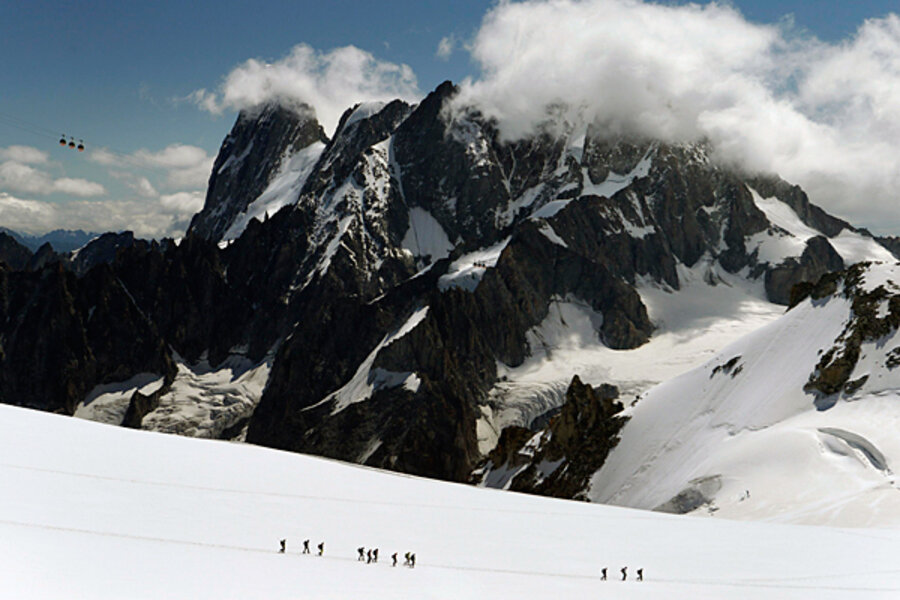Appearance of explosive WWI relics underscores Alps glaciers' retreat
| Rome
They lay undetected for more than a century, a hidden legacy of the highest, most forbidding battlefield of World War I.
But last month, as Italy sweltered through one of the hottest summers on record, a cache of more than 200 rusted explosives emerged from beneath a melting sheet of ice in the Dolomite range in the country’s north.
The appearance of the explosives – at the end of the hottest summer since 2003 and one of the warmest since record keeping began – fed concerns about Italy’s rapidly dwindling glaciers and the threat posed by global warming. Across the Alps – not just in Italy but in neighboring Austria, Switzerland, and France – glaciers are in retreat at an alarming rate due to rising temperatures.
“In the worst-case scenario, by the end of the century glaciers in the Alps will be reduced to 5 to 10 percent of what we have now,” says Michael Zemp, a scientist with the World Glacier Monitoring Service.
'Strange objects' in the ice
The explosives – probably stored in an ammunition dump carved into what was once a massive glacier – were discovered by mountain-rescue experts during a routine border-police patrol.
They emerged from the 10,500-foot-high Ago di Nardis glacier in the Trentino region of northern Italy, which, during World War I, was bitterly contested by Italian troops fighting the opposing forces of the Austro-Hungarian empire.
The armaments, each weighing up to 22 lbs., were removed after the patrol noticed “strange objects” sticking out of the melting mass of ice.
The discovery was one of the more unusual manifestations of a phenomenon that has governments, economists, and environmentalists deeply worried.
Mountaineers and hikers are also seeing more avalanches and rock falls as the morphology of the Alps changes.
When a large iron cross tumbled from its pedestal on the summit of the Dolomites’ highest peak earlier this month, its collapse was blamed on its rock base fracturing as a result of melting permafrost.
Four days later, mountain climbers in Austria removed a similar cross from the 11,800-foot-high Grossvenediger peak because they feared it, too, had become dangerously unstable.
A worsening trend
More than half of the ice-covered area of the Alps has disappeared since 1850, the end of a cold spell known as the Little Ice Age.
In the past 120 years, the Alps have undergone an “exceptionally high temperature increase of around two degrees centigrade,” according to the European Topic Center on Air and Climate Change, a consortium of European environmental institutes.
But even over the past few decades, there are clear changes to the Alps.
- In the Austrian Tirol, some glaciers have retreated 22 feet in the past decade.
- In Switzerland, skiers used to be able ski on four glaciers in the summer – now that number has dwindled to two.
- In Italy’s Stelvio National Park in the Dolomites, glaciers have shrunk by up to 40 percent in the past 50 years.
- At the other end of the Alpine range, in the Val d’Aosta region close to France, glaciers have been reduced in size by 27 percent in the past three decades.
There will be serious implications for tourism activities such as skiing, as well as agriculture, industry, and human habitation.
Glaciers currently release their meltwater during the summer, when it is most needed. That crucial supply will be drastically reduced as the ice masses disappear, affecting farming as well as industrial activity.
Melting glaciers can also lead to natural hazards – new lakes form, but can burst with no warning, threatening towns and villages in the valleys below.
While this summer was “an exceptional event”, it only exacerbated a trend that was already well under way, Guglielmina Diolaiuti, the head of the scientific committee of the Italian Alpine Club, told AKI, an Italian news agency.
Italian scientists have found that in the last few decades, the altitude at which glaciers can form has marched up the mountains by around 330 feet.
Saving the glaciers
Extreme measures are being taken to preserve Europe’s glaciers, including covering them with huge tarpaulins that deflect the sun’s rays.
They have had some success – at Presena in northern Italy, 90,000 square meters of sheeting have reduced the rate at which a glacier is melting by up to 70 percent.
Similar measures are being mooted for a landmark peak in the Dolomites called La Marmolada.
But the tarpaulins are expensive, as well as being unsightly, and scientists say they are hardly sustainable in the long term.
So can Europe’s glaciers be saved? “It depends on us as a society,” says Dr. Zemp, who is based at Zurich University in Switzerland.
Man-made climate change, caused by greenhouse gases, needs to be halted as soon as possible, he says. “But even if we freeze climate change to its present rate, the effect will be delayed and glaciers will still reduce by 10 to 30 percent by the end of the century. That’s the most optimistic scenario. So far we have seen no progress in stopping climate change. It’s not hopeless, but we need action right now.”





